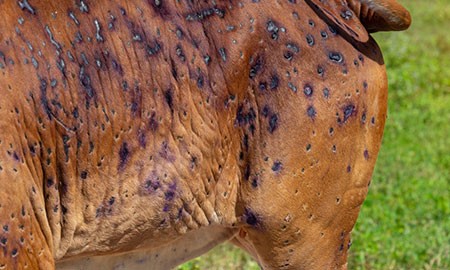Scientific name: Capripoxvirus
About LSD
- This disease causes cattle and water buffalo to become severely unwell.
- Milk production in animals with LSD is significantly impacted.
- LSD may also cause cows to abort their young.
- Countries with an LSD outbreak loose access to global markets.
- LSD is primarily spread by biting insects such as certain species of flies, mosquitos and possibly ticks.
- The disease can also be spread through contaminated equipment, and in some cases directly from animal to animal.
- Infection typically causes an acute disease with fever, depression and characteristic skin nodules.
- Some animals with the disease may be asymptomatic (have the disease with not show signs).
- There may also be a marked reduction in milk yield or can cause abortion in pregnant animals.
- Once present, this disease can be challenging and costly to control or eradicate.
Countries LSD has spread to
- The disease has spread from Africa, through China and Southeast Asia.
- In 2012 the disease was confirmed in Vietnam, Thailand and Malaysia.
- In March 2022 it was reported in Indonesia and on the Island of Sumatra.
Animals that can be infected by LSD
- Cattle
- Water buffalo
What to look for
- Firm, raised nodules up to 50mm in diameter develop on the skin around the head, neck, genitals and limbs or any part of the body
- Scabs in the centre of the nodules
- Large holes that may have formed after the scabs have fallen off
- These holes may be infected
- Swelling of the limbs, brisket and genitals
- Watering eyes
- Increased nasal and salivary secretions
How to protect your animals
If there is an outbreak in your country, slowing the spread of the disease may include,
- vaccination
- controlling movement of animals
- minimising populations of ticks, flies, mosquitoes and flea
- culling infected animals.
What to do if you find it
- If you have any suspicion of LSD, report it to your local biosecurity authority.
- If possible, take a photo to help identify it.

